
As winter blankets Alberta in a snowy embrace, homeowners often shift their focus from lawn care to cozy indoor activities. However, your lawn remains a resilient and fascinating part of your property even during the coldest months.
In this blog, we’ll explore 10 surprising facts about your lawn and grass in Alberta during winter, shedding light on the hidden wonders beneath the snow.
1. Winter Dormancy
-
- Contrary to appearances, your grass is not lifeless beneath the snow. Instead, it enters a state of dormancy, conserving energy and resources until the warmer months. This adaptive mechanism helps protect the grass from extreme winter conditions.
- This photo is from Shutterstock and illustrates “Swirls in grass caused by unsynchronized dormancy, a term that refers to grass going dormant at different stages.”
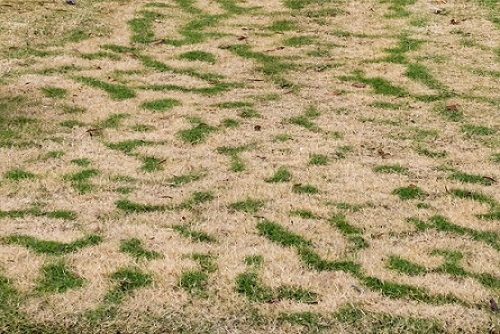
2. Snow as a Natural Insulator
-
- Snow is not just a picturesque winter scene; it serves as a natural insulator for your lawn. The snow cover acts as a protective blanket, shielding the grass from harsh temperatures and providing a stable environment.
3. Frost Heaving
-
- Alberta’s freezing temperatures can lead to an interesting phenomenon known as frost heaving. This occurs when the soil alternately freezes and thaws, causing the ground to shift. Grass adapts by adjusting its root system to accommodate these changes.
4. Lawn Diseases Lurking Below
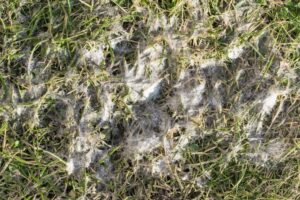
Some lawn diseases, such as snow mould and pink snow mould, can thrive beneath the snow. Snow mould, a common issue in winter, is caused by a fungus that thrives in cold, damp conditions. While it may seem alarming, snow mould is generally harmless and disappears as the weather warms up. Proper lawn care practices can help prevent its occurrence. Learn more about lawn diseases in our blog, “Lawn Diseases to Watch Out For“.
5. Animal Activity Beneath the Snow
-
- Your lawn is not a deserted land in winter. Beneath the snow, small animals like voles and mice may create intricate networks of tunnels. While this can be detrimental to the grass, it’s a testament to the ecosystem’s resilience.
6. Evergreen Grass
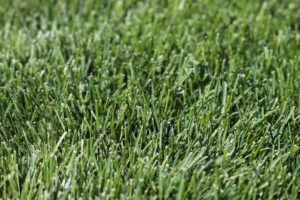
-
- Some grass varieties, such as Kentucky Bluegrass, can maintain a green hue even in winter. These evergreen qualities add a touch of vibrancy to your lawn during the cold season, creating a visually appealing contrast against the snow.
7. Deicing Salt Dilemma
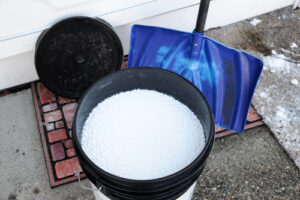
-
- While deicing salts are essential for safety in icy conditions, they can have adverse effects on your lawn. Salt accumulation in the soil can lead to damage, causing soil compaction and hindering the grass’s ability to absorb nutrients.
8. Winter Wildlife Haven
-
- Alberta’s winter turns your lawn into a wildlife haven. Birds, such as winter finches and snow buntings, find shelter in the grass, adding a delightful touch of nature to your outdoor space.
9. Invisible Ice Nucleators
- Grass has a remarkable ability to act as an “invisible ice nucleator”.
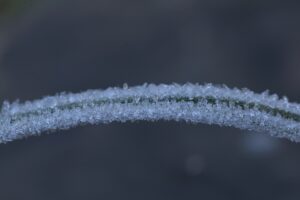
- This means that certain types of grass, particularly cool-season grasses like Kentucky bluegrass, can initiate the formation of ice crystals at temperatures slightly above freezing. This unique property allows grass to withstand frost and freezing temperatures more effectively, contributing to its resilience in cold climates.
10. Early Spring Preparations
-
- Winter in Alberta may be long, but it’s never too early to start thinking about spring. Taking certain preparatory steps during winter, such as using deicing salts that are safe for your soil and lawn and avoiding compacting the lawn, can set the stage for a lush and vibrant lawn when the snow finally melts. Learn more about spring lawn care in our blog, “The Do’s and Don’ts on Spring Lawn Care“.
As you enjoy the winter wonderland in Alberta, take a moment to appreciate the resilience and adaptability of your lawn. Understanding these surprising facts about your grass in winter allows you to make informed decisions for optimal lawn care, ensuring a healthy and beautiful outdoor space throughout the changing seasons.
If you have any questions about caring for your lawn, please feel free to contact our team.

Recent Comments